Pas de biographie disponible.
Compositeur Musique additionelle Librettiste Parolier Metteur en scène Chorégraphe Producteur création Producteur version
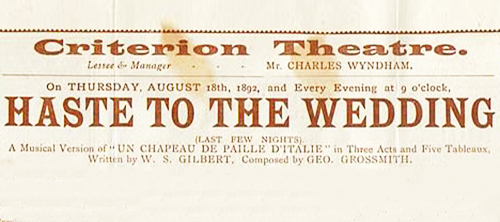
Musical
Musique: George Grossmith • Paroles: Livret: W.S. Gilbert • Production originale: 1 version mentionnée
Dispo: Synopsis Génèse Liste chansons
The plot of Haste to the Wedding is, in Gilbert's his own words, "a very free adaption" of Eugène Labiche and Marc-Michel's 1851 farce Le Chapeau de Paille d'Italie. Gilbert had adapted this French play in 1873 under the title The Wedding March, and later wanted to collaborate with Sullivan on a musical setting of the piece, but nothing came of the project. Eventually, Gilbert got George Grossmith, the Savoy's principal comedian, to compose the music. Haste to the Wedding opened on July 27, 1892.
Genèse: The Wedding March On 15 November 1873, Gilbert's play The Wedding March debuted at the Court Theatre, written under his pseudonym F. Latour Tomline. It was a free adaptation of Eugène Marin Labiche's Un chapeau de paille d'Italie ("The Italian Straw Hat"). The play was first to have been called Hunting a Hat, but the title was changed to capitalise on the popularity of the wedding march from Wagner's Lohengrin. The name of the hero, Woodpecker Tapping, was taken from Thomas Moore's ballad, "The woodpecker tapping the hollow beech tree." The play ran for about 92 performances, until 3 March 1874, a good run for the time. On the play's success, Stedman notes: "Gilbert's adaptation is a model of how a French farce could be intelligently suited to the English stage.... It depended on split-second timing, on rapid intrusions and concealments, on frantically invented expedients and mistaken identities, and on the pursuit of a crucial object: a hat of Italian straw." The Era commented that there was "enough fun... to make half-a-dozen ordinary farces." The piece was "one of Gilbert's most frequently played successes and brought him £2,500".[4] He told the critic William Archer, in 1904, that he had written it in just a day and a half. The play was given as part of a benefit matinee at the Gaiety Theatre, London, on 4 December 1884 with a cast starring Lionel Brough and Lydia Thompson. The idea of turning The Wedding March into an opera was on Gilbert's mind for many years. The project was mooted in 1876 as a successor to Trial by Jury. Arthur Sullivan would have composed the score, and the composer's brother Fred (Trial's Learned Judge) would have played the bridegroom, Woodpecker Tapping, but the opera didn't materialise, perhaps due to the illness that ultimately led to Fred's early death. The script of The Wedding March makes several references to an Irish song called "Haste to the Wedding", which became the title of the later version. Creation of the opera; subsequent adaptation By the 1890s, Gilbert's partnership with Sullivan had unravelled, and Gilbert had to find other partners. He wrote The Mountebanks with Alfred Cellier, and then turned to George Grossmith, the comic baritone of the Gilbert and Sullivan pieces from The Sorcerer (1877) through to The Yeomen of the Guard (1888). Grossmith had composed hundreds of songs and duets for his own private drawing-room entertainments, as well as a few short comic operas, but never a full-length work as ambitious as Haste to the Wedding. By opening night, 27 July 1892, Gilbert was approaching a reconciliation with Sullivan, who was in attendance. Notable among the cast were Frank Wyatt as Woodpecker Tapping, veteran actor Lionel Brough (Pietro in The Mountebanks) as Maguire, and George Grossmith Jr., the composer's son, in his stage debut as Foodle. The opera was not a success, however, playing only 22 performances. Stedman suggests that the timing of the premiere in July, traditionally a slow season, worked against it. Gänzl sums up the failure: "...the setting of the lyrics proved rather too much for Grossmith, whose musical talent, though tuneful and amusing, was definitely on the small scale. The songs added nothing to the play and indeed, by breaking down the plot and slowing the pell-mell pace of the action, exposed the improbability of the situations. After a first night which evoked some wrathful comments from a disappointed audience, Haste to the Wedding survived only twenty-two performances." At Chichester (1975) and Exeter (1976), an adaptation was created using Gilbert's The Wedding March as a starting point, adding the lyrics and music from Haste to the Wedding, as well as additional original lyrics written to music adapted from Jacques Offenbach’s Barbe-Bleue. This piece was called The Italian Straw Hat and played strongly for limited seasons.
Résumé:
Création: 27/7/1892 - Criterion Theatre (Londres) - 22 représ.

Musical
Musique: Cole Porter • Willie Redstone • Paroles: Clifford Grey • Livret: George Grossmith • Production originale: 1 version mentionnée
Dispo: Résumé Commentaire Isnpiration Liste chansons
"A Night Out" est une comédie musicale adaptée de la comédie française , "L’Hôtel du libre échange" de Georges Feydeau et Maurice Desvallières (1894).
Genèse:
Résumé: Acte I Le sculpteur Joseph Pinglet est frappé par son épouse dominatrice et est prêt à se rebeller par une petite sortie non autorisée. Il a l'intention de dîner avec la jolie Marcelle Delavaux, la fiancée négligée de Maurice Paillard, dans une salle privée de l'hôtel Pimlico. Mais Madame Pinglet a été convoquée pour rendre visite à sa sœur malade, et elle enferme son mari dans son atelier avant de partir. Pinglet utilise le tire-cloche comme une corde et s'échappe par le balcon. Acte II Pinglet et Marcelle sont arrivés à l'hôtel. À leur insu, Monsieur Matthieu et ses quatre jeunes filles, ont eux reçu une chambre réputée hantée. Par un oubli, la même chambre a également été attribuée à Maurice Paillard, qui a l'intention de passer une soirée intime avec Victorine, la bonne des Pinglets. Pinglet et Marcelle sont dérangés par les coups frénétiques à leur porte et la voix de Paillard, qui a été terrifié de trouver dans sa chambre quatre personnages en blanc - les filles de Matthieu - qu'il suppose être des fantômes. La confusion est aggravée par une descente de police. La police prend les noms de toutes les personnes présentes. Victorine lui donne le nom de Madame Pinglet. De retour à son atelier, Pinglet monte juste avant le retour de sa femme. Elle est très échevelée suite à un accident de la circulation. Les convocations arrivent de la police. Pinglet voit le nom de Mme Pinglet sur l'une d'elles et se retourne contre sa femme déconcertée et lui reproche son comportement licencieux. Les policiers arrivent avec les autres qui ont été à l'hôtel. Dans toutes les péripéties qui suivent la prétendue imposture de Victorine, le rôle de Pinglet et Marcelle dans les événements de la soirée restent sertets et ils échappent aux conséquences néfastes de leur soirée.
Création: 18/9/1920 - Winter Garden Theatre (Londres) - 309 représ.
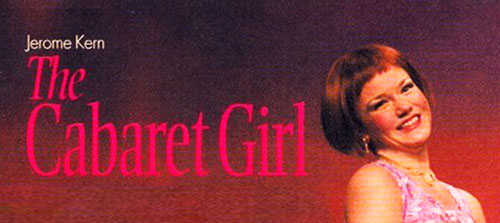
Musical
Musique: Jerome Kern • Paroles: P. G. Wodehouse • Livret: George Grossmith • P.G. Wodehouse • Production originale: 1 version mentionnée
Dispo: Résumé Commentaire Génèse Liste chansons
Genèse: L'acteur-manager George Grossmith, Jr. et son partenaire Edward Laurillard ont acheté le New Middlesex Theatre dans le West End de Londres en 1919 et, après sa remise en état, le rouvrirent sous le nom de Winter Garden Theatre. La première production a été "Kissing Time", écrite par P. G. Wodehouse et Guy Bolton avec Grossmith et Leslie Henson. Deux ans plus tard, après la rupture de l’association de Grossmith avec Laurillard, Grossmith conserva le contrôle du Winter Garden où, entre 1921 et 1926, en partenariat avec Pat Malone, il produisit une série de spectacles, dont beaucoup étaient des adaptations de spectacles importés et comportaient Leslie Henson dans la distribution. La première production du partenariat Grossmith-Malone a été "Sally", avec la musique de Jerome Kern, un livret de Bolton et certaines des paroles de Wodehouse, qui était le transfert à Londres d’un succès de Broadway. Le second, avec un livre original, était "The Cabaret Girl". Kern et Wodehouse avaient tous deux travaillé avec Grossmith au début de leur carrière et avaient, avec Bolton, créé une série novatrice de comédies musicales pour le Princess Theatre de Broadway. Dans son autobiographie de 1933, Grossmith décrit comment lui, Wodehouse et Kern géraient leur collaboration. Alors que les deux écrivains se rendaient à New York, rédigeant les paroles des numéros d’ensemble et des finales sur le bateau, Kern était déjà au travail chez lui à Bronxville, New York, pour composer les mélodies. Lorsque le trio s’est réuni à Bronxville, Kern a commencé à mettre en musique les paroles complètes, tandis que Grossmith et Wodehouse ont préparé des paroles "factices" pour les mélodies de Kern, les paroles mêmes étant terminées lors du voyage de retour. Le trio a travaillé à partir de copies piano ou "violon" de la musique, laissant Kern pour les suivre à Londres avec l’orchestration terminée quelques semaines plus tard.
Résumé: James (« Jim ») Paradene, neveu de la Marquise d’Harrogate, est amoureux de Marilynn Morgan, une choriste sans travail qui auditionne actuellement pour le nouveau spectacle de cabaret « All Night Follies » des Gravinns & Gripps. Jim a un autre problème, il ne peut hériter de la fortune de son père tant qu’il n’est pas marié avec l’approbation des administrateurs – et les administrateurs sont la marquise et son fils guindé. James persuade Gravinns de se joindre à une tromperie : ils prétendront que James et Marilynn sont mariés et inviteront les administrateurs et les « richards » locaux à la maison de campagne de Gripps, la faisant passer pour appartenant à Marilynn. Faute de « richards » locaux, les artistes du cabaret se font passer pour des aristocrates et Gravinns se fait passer pour le vicaire. La Marquise approuve Marilynn jusqu’à ce que le vrai Vicaire arrive et les démasque tous. Marilyn avoiue tout mais refuse formellement Jim et retourne précipitamment à Londres. Jim, bien sûr, suit - déterminé à épouser la jeune fille et déclarant « merde à l’héritage! »
Création: 19/9/1922 - Winter Garden Theatre (Londres) - 361 représ.
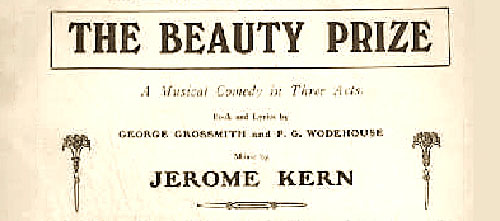
Musical
Musique: Jerome Kern • Paroles: George Grossmith • P. G. Wodehouse • Livret: George Grossmith • P.G. Wodehouse • Production originale: 1 version mentionnée
Dispo: Résumé Génèse Liste chansons
Genèse: The Beauty Prize est créé par Grossmith et Malone le 5 septembre 1923 au Winter Garden Theatre, Drury Lane, de Londres. Il a été conçu pour remplacer The Cabaret Girl, que la même équipe avait produit avec beaucoup de succès l’année précédente, dans le même théâtre et avec principalement la même distribution, mais n’a pas réussi à obtenir le même succès. The Beauty Prize a vu sa première production américaine lorsqu’il a été présenté en concert par Musicals Tonight! au 45th Street Theatre, New York, du 26 avril au 8 mai 2005.
Résumé: John Brooke, un riche jeune Anglais, et Carol Stuart, fille d’un riche Américain, se rencontrent à un bal où ils font semblant d’être pauvres, tombent amoureux et se fiancent. Plus yard, John est horrifié lorsque sa secrétaire Flutey Warboy lui montre la photo de Carol dans un journal – elle participe à un concours de beauté pour gagner un mari riche. John ne sait pas que Carol n’a rien à voir avec ça, et la photo a été fournie par son admirateur, l’assistante de la modiste, Lovey Toots. Le jour de leur mariage, Odo Philpotts arrive, disant que Carol a gagné le concours et qu’il est le prix. Mme Hexal, chaperon de Carol, dit à John que Carol est une héritière et doit avoir un mari riche. John sermone furieusement Carol, qui, dans un accès de colère, annonce qu’elle va épouser Odo. John riposte en menaçant d’épouser Lovey. Flutey trouve un moyen de démêler tout cela, avec de faux télégrammes disant que John et Carol ont tous deux perdu tout leur argent, et qu’ils sont maintenant tous les deux pauvres – et de retour là où ils pensaient qu’ils étaient au début de leur relation. Cela, bien sûr, mène à une fin heureuse…
Création: 5/9/1923 - Winter Garden Theatre (Londres) - 214 représ.
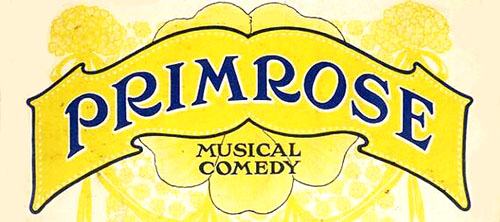
Musical
Musique: George Gershwin • Paroles: Desmond Carter • Ira Gershwin • Livret: George Grossmith • Guy Bolton • Production originale: 1 version mentionnée
Dispo: Résumé Génèse Liste chansons
Primrose is a musical in three acts with a book by Guy Bolton and George Grossmith Jr., lyrics by Desmond Carter and Ira Gershwin, and music by George Gershwin. It centers on a writer whose story-within-a-story forms the basis of the plot. It was written expressly for the London stage, where it ran for 255 performances in 1924 and 1925. George Gershwin, at 25 years old, was an established songwriter by 1924 when Grossmith and his producing partners, J. A. E. Malone and Edward Laurillard, hired him to produce the score for Primrose for them in London. The musical is the first in which Gershwin wrote some of the orchestrations himself. The year was one of the busiest for Gershwin, as it also included his Rhapsody in Blue and two other musicals. Gershwin's score, and the book by Bolton are old-fashioned for their time, with more in common with the frothy Edwardian musical comedies than with the later Gershwin musicals.
Genèse: Primrose was produced by Grossmith and J. A. E. Malone, who wanted to follow up on their earlier successes composed by Jerome Kern.[2] It opened at the Winter Garden Theatre in London on 11 September 1924 only two months before the Gershwins’ Lady, Be Good! debuted on Broadway. The cast featured comedian Leslie Henson and also included Claude Hulbert, Heather Thatcher and opera baritone Percy Heming. The director was Charles A. Maynard, and the choreographer was Laddie Cliff.[5][6] Extensive excerpts from the score were recorded with original 1924 cast members conducted by Ansell, and have been re-released on CD. P. G. Wodehouse rewrote the lyric of 'When Toby is out of Town' as 'The Twenties are Here to Stay', interpolated into a 1960 revival of Gershwin's Oh, Kay! In their joint memoir Bring on the Girls!, Wodehouse and Bolton relate a story about Grossmith holding auditions for Primrose, where he made a routine request of Sylvia Hawkes, a beautiful young dancer, who later married a series of famous men: "Must I sing, Mr Grossmith?" "Yes, Sylvia, you must. All of you have to sing if you want jobs as showgirls in Primrose. The Gershwin score demands it." "Oh very well," she replied petulantly, and, going down to the floats she handed over a piece of music to the pianist in the pit. The piano struck a chord. "God save our gracious King, Long live our noble King, God save the King." Grossmith, a strict observer of ritual, rose and stood at attention. His minions rose and stood at attention. Guy, on his way to announce his arrival, stood at attention. As the anthem came to the normal stopping point, George started to sit down, but there is more, much more of the fine old chorale than is generally known. James Carey is credited with a three-stanza version; in another version John Bull... has expressed the same sentiment in his own way; while James Oswald... also got into the act. A printing is extant giving them all. Sylvia Hawkes sang them all. The pianist stopped playing, but that didn't stop Sylvia. They wanted her to sing, did they? Well, sing she would. Of course no one dared to call a halt. The national anthem is sacrosanct – especially if you're an actor-manager clinging to the hope of a belated knighthood. An Australian production with Maude Fane and Alfred Frith opened in Melbourne, at His Majesty's Theatre in April 1925, before touring nationally. It was produced by J. C. Williamson's company. The show was not produced on Broadway, where it would have competed with Lady, Be Good!. The American première of Primrose did not take place until 1987, when an unstaged concert production at the Coolidge Auditorium of the Library of Congress was given, without dialogue, together with another Gershwin score, Pardon My English (1933), both conducted by John McGlinn.[10] Soloists included Rebecca Luker and Kim Criswell. The next performance in North America was in 2003, when Musicals Tonight! presented a series of staged concerts at the 14th Street YMCA in New York City's Greenwich Village, with dialogue, but accompanied only by piano, directed by Thomas Mills. Ohio Light Opera mounted the first fully staged American production of the show in 2017.
Résumé: Primrose consists of three interconnected love stories about Freddie and May, Hilary and Joan, and Toby and Pinkie. Freddie is reluctantly engaged to his cousin Joan, but falls in love with amateur golfer May Rooker. Joan, a naive, pretty young socialite, loves dashing Hilary Vane, a successful author of romantic yarns who lives on a houseboat. Hilary is writing a story whose heroine, Miss Primrose, is at a similar impasse. Hilary returns Joan's love, but Freddie and Joan are under the thumb of Sir Barnaby Falls – Joan's guardian and Freddie's uncle – who, for financial reasons, refuses consent to their marrying anyone except each other. The romance of aristocratic Toby Mopham and the vulgar but ambitious beautician Pinkie Peach is impeded by Toby's second thoughts after rashly proposing; he enlists Hilary's to pretend to woo Pinkie so that Toby can catch them in flagrante and break off the engagement. However, Joan also catches Hilary wooing Pinkie. During an eventful dance sequence, Toby overcomes his reluctance to marry, Sir Barnaby gives way, and all three couples are free to marry.
Création: 11/9/1924 - Winter Garden Theatre (Londres) - représ.
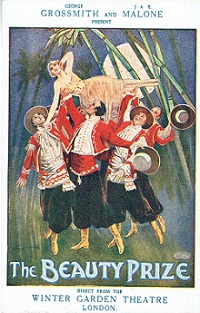
Version 1
Beauty Prize (The) (1923-09-Winter Garden Theatre-London)
Type de série: OriginalThéâtre: Winter Garden Theatre (Londres - Angleterre) Durée : 6 mois Nombre : 214 représentationsPremière Preview : Wednesday 05 September 1923Première : Wednesday 05 September 1923Dernière : Saturday 08 March 1924Mise en scène : George Grossmith • Chorégraphie : Fred Leslie • Producteur : Avec : Jack Hobbs (John Brooke), Dorothy Dickson (Carol Stuart), George Grossmith (Flutey Warboy), Heather Thatcher (Lovey Toots), Leslie Henson (Odo Philpotts), Sheila Courtney (Mrs Hexal).Commentaires : Malgré des avis indifférents et des critiques pour un livret plutôt faible, le spectacle a réussi un cycle de six mois.
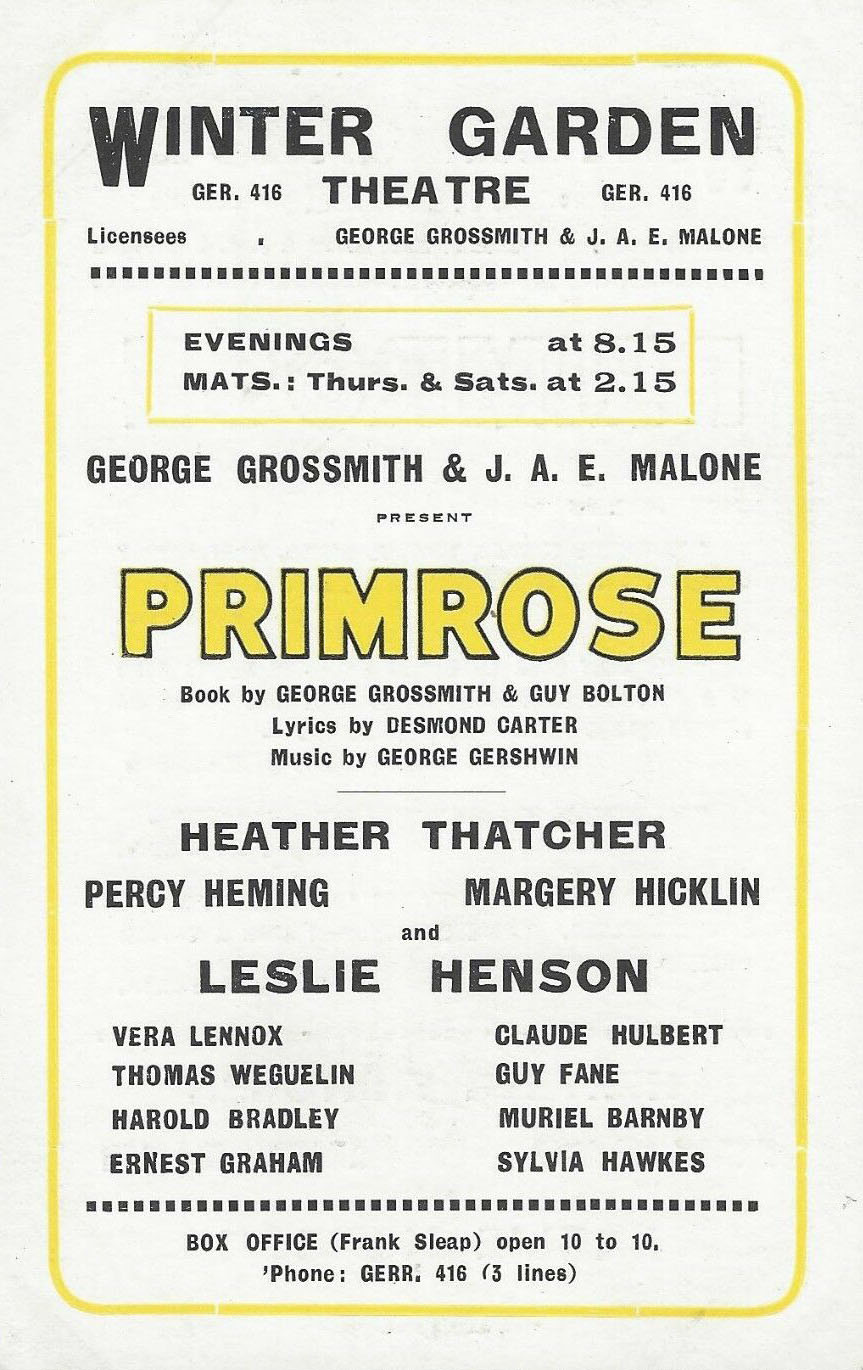
Version 2
Primrose (1924-09-Winter Garden Theatre-Londres)
Type de série: OriginalThéâtre: Winter Garden Theatre (Londres - Angleterre) Durée : 7 mois 2 semaines Nombre : 255 représentationsPremière Preview : Thursday 11 September 1924Première : Thursday 11 September 1924Dernière : Saturday 25 April 1925Mise en scène : George Grossmith • Chorégraphie : Producteur : Avec : Margery Hicklin (Joan), Guy Fane (Sir Benjamin Falls), Percy Heming (Hilary Vane), Leslie Henson (Toby Mopham), Heather Thatcher (Pinkie Peach), Claude Hulbert (Freddie Falls), Vera Lennox (May Rooker), Muriel Barnby (Lady Mopham)Commentaires : George Grossmith, qui a écrit le livret, et a dirigé le spectacle, voulait se présenter comme Hilary Vane, mais George Gershwin a insisté pour avoir un «bon» chanteur pour le rôle. Percy Heming a chanté de nombreux grands rôles d’opéra ainsi que von Schober dans « Lilac Time », il a donc été imaginé comme alternative à Grossmith, qui est toujours resté légèrement frustré qu’on ne l'ait pas considéré comme assez bon!

Version 3
Sally (1921-09-Winter Garden Theatre-London)
Type de série: Original LondonThéâtre: Winter Garden Theatre (Londres - Angleterre) Durée : Nombre : 387 représentationsPremière Preview : Saturday 10 September 1921Première : Saturday 10 September 1921Dernière : InconnuMise en scène : George Grossmith • Chorégraphie : Jack Haskell • Producteur : Avec : Alaric Arnée (Pops Schendorff), Leslie Henson (“Connie”), Dorothy Dickson (Sally), Molly Ramsden (Mrs Ten Broeck), Gregory Stroud (Blair Farquar), Seymour Beard (Jimmie Spelvin), George Grossmith (Otis Hooper), Heather Thatcher (Rosie Rafferty), Ernest Graham (Richard Farquar)
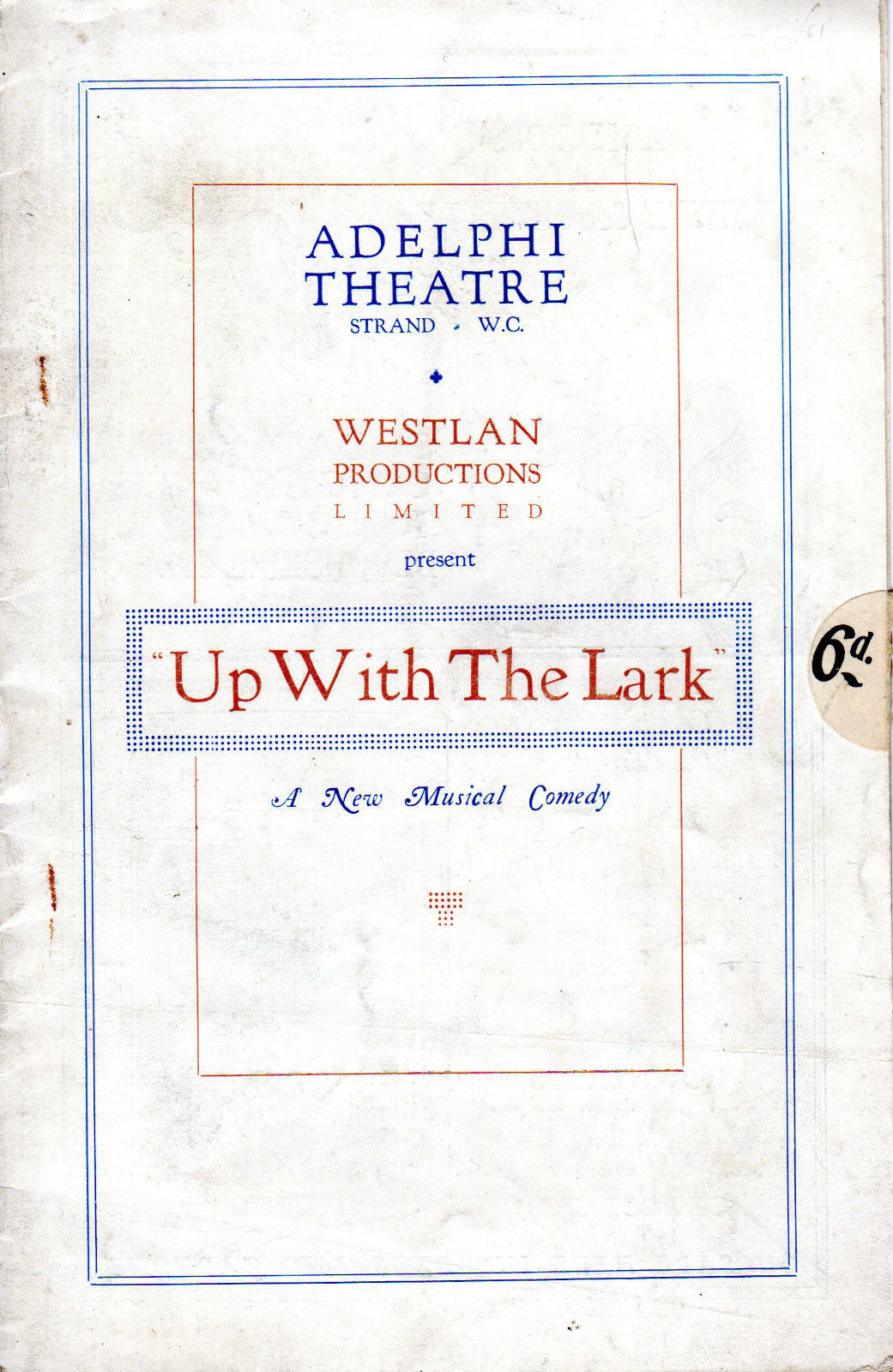
Version 4
Up With the Lark (1927-08-Adelphi Theatre-London)
Type de série: OriginalThéâtre: Adelphi Theatre (Londres - Angleterre) Durée : 2 mois 2 semaines Nombre : 92 représentationsPremière Preview : Thursday 25 August 1927Première : Thursday 25 August 1927Dernière : Saturday 12 November 1927Mise en scène : George Grossmith • Chorégraphie : Max Rivers • Ethel Heliwell • Producteur : Avec : Leslie Sarony, Adrienne Ash, Henry Wenman, Diana Wilson, Billie Hill, Austin Melford, Allen Kearns, Anita Elson, Robert Michaelis, W.A. Haines, Charles King et Harry Pringle.